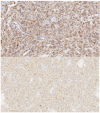Pheochromocytomas and Paragangliomas: New Developments with Regard to Classification, Genetics, and Cell of Origin
- PMID: 31362359
- PMCID: PMC6721302
- DOI: 10.3390/cancers11081070
Pheochromocytomas and Paragangliomas: New Developments with Regard to Classification, Genetics, and Cell of Origin
Abstract
Pheochromocytomas (PCC) and paragangliomas (PGL) are rare neuroendocrine tumors that arise in the adrenal medulla and in extra-adrenal locations, such as the head, neck, thorax, abdomen, and pelvis. Classification of these tumors into those with or without metastatic potential on the basis of gross or microscopic features is challenging. Recent insights and scoring systems have attempted to develop solutions for this, as described in the latest World Health Organization (WHO) edition on endocrine tumor pathology. PCC and PGL are amongst the tumors most frequently accompanied by germline mutations. More than 20 genes are responsible for a hereditary background in up to 40% of these tumors; somatic mutations in the same and several additional genes form the basis for another 30%. However, this does not allow for a complete understanding of the pathogenesis or targeted treatment of PCC and PGL, for which surgery is the primary treatment and for which metastasis is associated with poor outcome. This review describes recent insights into the cell of origin of these tumors, the latest developments with regard to the genetic background, and the current status of tumor classification including proposed scoring systems.
Keywords: GAPP; PASS; SDHB; paraganglioma; pheochromocytoma; scoring system; tumor classification.
Conflict of interest statement
The authors declare no conflict of interest.
Figures

Similar articles
-
Overview of the 2022 WHO Classification of Paragangliomas and Pheochromocytomas.Endocr Pathol. 2022 Mar;33(1):90-114. doi: 10.1007/s12022-022-09704-6. Epub 2022 Mar 13. Endocr Pathol. 2022. PMID: 35285002 Review.
-
Predicting Metastatic Potential in Pheochromocytoma and Paraganglioma: A Comparison of PASS and GAPP Scoring Systems.J Clin Endocrinol Metab. 2020 Dec 1;105(12):e4661-70. doi: 10.1210/clinem/dgaa608. J Clin Endocrinol Metab. 2020. PMID: 32877928 Free PMC article.
-
Paragangliomas: update on differential diagnostic considerations, composite tumors, and recent genetic developments.Semin Diagn Pathol. 2013 Aug;30(3):207-23. doi: 10.1053/j.semdp.2013.06.006. Semin Diagn Pathol. 2013. PMID: 24144290 Review.
-
Pheochromocytoma and Paraganglioma: From Epidemiology to Clinical Findings.Sisli Etfal Hastan Tip Bul. 2020 Jun 3;54(2):159-168. doi: 10.14744/SEMB.2020.18794. eCollection 2020. Sisli Etfal Hastan Tip Bul. 2020. PMID: 32617052 Free PMC article. Review.
-
Hypoxia Pathway Mutations in Pheochromocytomas and Paragangliomas.Cytogenet Genome Res. 2016;150(3-4):227-241. doi: 10.1159/000457479. Epub 2017 Feb 24. Cytogenet Genome Res. 2016. PMID: 28231563 Review.
Cited by
-
Paraganglioma of the Neck: A Rare Case With Spinal Metastasis.Case Rep Oncol Med. 2024 Apr 26;2024:2025115. doi: 10.1155/2024/2025115. eCollection 2024. Case Rep Oncol Med. 2024. PMID: 38706789 Free PMC article.
-
Algorithm of genetic diagnosis for patients with head and neck paraganglioma-update.Front Neurol. 2024 Aug 29;15:1437027. doi: 10.3389/fneur.2024.1437027. eCollection 2024. Front Neurol. 2024. PMID: 39268066 Free PMC article.
-
Abdominal nonfunctional paraganglioma in which succinate dehydrogenase subunit B (SDHB) immunostaining was performed: a case report.J Med Case Rep. 2023 Mar 22;17(1):106. doi: 10.1186/s13256-023-03822-3. J Med Case Rep. 2023. PMID: 36945070 Free PMC article.
-
Computerized tomography texture analysis of pheochromocytoma: relationship with hormonal and histopathological data.J Endocrinol Invest. 2022 Oct;45(10):1935-1944. doi: 10.1007/s40618-022-01826-2. Epub 2022 Jun 10. J Endocrinol Invest. 2022. PMID: 35680695 Free PMC article.
-
Head and Neck Paragangliomas-A Genetic Overview.Int J Mol Sci. 2020 Oct 16;21(20):7669. doi: 10.3390/ijms21207669. Int J Mol Sci. 2020. PMID: 33081307 Free PMC article. Review.
References
-
- Chan W.H., Gonsalvez D.G., Young H.M., Southard-Smith E.M., Cane K.N., Anderson C.R. Differences in CART Expression and Cell Cycle Behavior Discriminate Sympathetic Neuroblast from Chromaffin Cell Lineages in Mouse Sympathoadrenal Cells. Dev. Neurobiol. 2016;76:137–149. doi: 10.1002/dneu.22304. - DOI - PMC - PubMed
-
- Ernsberger U., Esposito L., Partimo S., Huber K., Franke A., Bixby J.L., Kalcheim C., Unsicker K. Expression of Neuronal Markers Suggests Heterogeneity of Chick Sympathoadrenal Cells Prior to Invasion of the Adrenal Anlagen. Cell Tissue Res. 2005;319:1–13. doi: 10.1007/s00441-004-0996-1. - DOI - PubMed
Publication types
LinkOut - more resources
Full Text Sources

